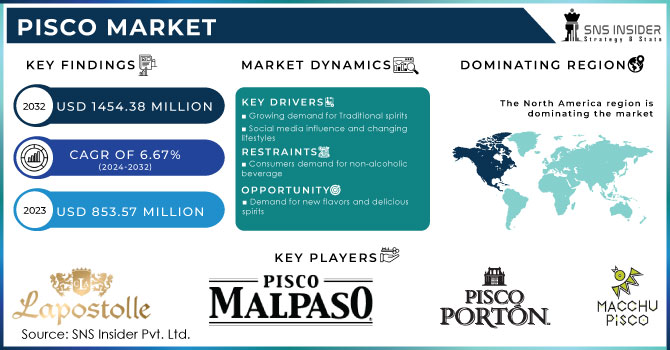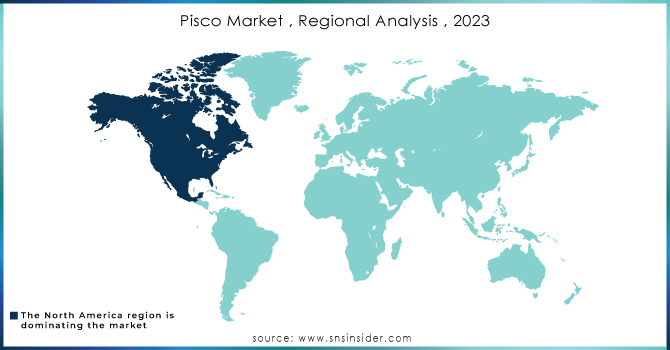Pisco Market Report Scope & Overview:

Get More Information on Pisco Market - Request Sample Report
The Pisco Market size was valued at USD 853.57 million in 2023 and is expected to reach USD 1454.38 million by 2032 and grow at a CAGR of 6.67% over the forecast period of 2024-2032.
Pisco is a type of brandy produced in winemaking regions of Peru and Chile. It is made by distilling fermented grape juice, it was developed by 16th-century Spanish settlers as an alternative to orujo, a pomace brandy that was being imported from Spain.
Based on Type, the pisco market is segmented into Pisco Puro, Mosto Verde, Acholado, and Others. Acholado, which translates to "half-bred," is made by blending a variety of grapes and letting the juice sit for a while. Each grape variety is separately fermented, and the longer it ferments, the more flavor it imparts to the beverage. As a result, tasty and distinctive blends are what drive this category. The market's aromatic versions are in high demand among millennials and other young people.
The Pisco Puro market, on the other hand, is anticipated to expand at the fastest rate since professional drinkers in Chile and Peru can enjoy a variety of distinctive and traditional flavors.
MARKET DYNAMICS
KEY DRIVERS
-
Growing demand for Traditional spirits
The expanding popularity of traditional spirits amongst consumers has increased demand for pisco and other comparable beverages, which is projected to further contribute to market growth. Pisco has become popular among health-conscious consumers due to its relationship with natural ingredients and antioxidants obtained from grapes. The growing recognition of traditional spirits amongst drinkers has influenced the rise in demand for pisco. Consumers worldwide are craving exotic drinks due to the unique experience they bring, propelling the alcohol sector forward.
-
Social media influence and changing lifestyles
RESTRAIN
-
Consumers demand for non-alcoholic beverage
Since Pisco contains alcohol, its popularity may decline as more people opt to drink non-alcoholic beverages. Around 95,000 Americans deceased in the United States as a result of alcohol-related problems, according to the National Institute on Alcohol Abuse and Alcoholism. The demand for non-alcoholic beverages has been pushed by customers' growing health concerns, wellness trends' expanding popularity, and consumers' increased awareness of the health dangers connected with alcohol intake.
OPPORTUNITY
-
Demand for new flavors and delicious spirits
The expanding practice of mixing multiple spirits to make new cocktails, or fusing various spirits to make distinctive alcoholic beverages, has recently been driving the industry. In addition, many producers have produced distinctive drinks like the Pisco Sour, El Capitan, and The Chilcano as a result, which have captured consumers all over the world. To push the boundaries of alcoholic beverage innovation, hybrid spirits also promote the exploration and expansion of more conventional alcoholic beverage categories. Additionally, several nations host a variety of drinking celebrations to promote regional beverages like pisco.
-
Expansion of the Pisco market in developing countries
CHALLENGES
-
Lack of awareness of Pisco drinks among consumers
In many parts of the world, pisco is still a relatively unknown spirit. Other alcoholic beverages, such as tequila and vodka, compete with pisco. They can be a threat to the expansion of the pisco business because they are more widely consumed in some regions of the world than others. The pisco market's expansion may be hampered by this ignorance.
IMPACT OF RUSSIA-UKRAINE WAR
The pisco market has been significantly harmed by the Russia-Ukraine conflict. Given that Russia and Ukraine are two of the main importers of pisco, the decline in shipments to these two nations is particularly alarming. When Russia started its horrific conflict with Ukraine, the once-thriving nation's wine industry sustained irreparable harm. In addition to being bombed and shelled by Russian soldiers as they withdrew, several vineyards, including those at Prince Trubetskoi Winery, were also dotted with land mines. Even though they imported pisco in the first quarter of 2023 compared to the corresponding time in 2022, pisco exports from Peru to Ukraine decreased by 70%.
IMPACT OF ONGOING RECESSION
A recession could lead to a decline in demand for pisco, as consumers may have less disposable income to spend on alcoholic beverages. The disruption in the supply chain, high shipment charges, and export duties have led to an increase in the prices of Pisco. Majorly pisco is exported from Peru and Chile to other countries. The average price of pisco in Peru increased by 10% in the first quarter of 2023 compared to the same period in 2022. Government policies, such as tax cuts or spending increases, could help to mitigate the impact of the recession on the pisco market.
MARKET SEGMENTATION
By Origin
-
Chilean
-
Peruvian
By Type
-
Pisco Puro
-
Mosto Verde
-
Acholado
-
Others
REGIONAL ANALYSIS
South America dominated the global Pisco market in 2023, accounting for the largest market share. Latin America is one of the key markets for Pisco because of rising demand and massive production in Chile and Peru. The region's top producers are reviving the spirits category, which is driving the market. A group that represents all of the country's distilleries, Pisco Chile, claims that the market has altered significantly in recent years, with premium and ultra-premium labels making up around 70% of the categories. Additionally, producers are expanding their exports and coming up with fresh and creative cocktail recipes to promote these spirit varieties and tap into their untapped market potential, which is boosting the business.
Europe is predicted to hold the second-largest market share. The increased popularity of traditional spirits in nations like the United Kingdom, Germany, and Russia has fueled industry expansion. The Association of Peruvian Exporters also notes an increase in the imports of the country's premium goods into Russia, which has helped the performance of the regional market.
North American market for pisco is growing rapidly, driven by the increasing popularity of pisco cocktails and the growing awareness of pisco among consumers. The United States is the largest market for pisco in North America, followed by Canada.
Asia Pacific region's market is expanding fast owing to the rising cultural understanding between Peru and major nations like China, India, and Japan. Additionally, expanding trade activities to take advantage of South America's untapped potential creates new prospects for market expansion in the area.

Need any customization research on Pisco Market - Enquiry Now
REGIONAL COVERAGE
North America
-
US
-
Canada
-
Mexico
Europe
-
Eastern Europe
-
Poland
-
Romania
-
Hungary
-
Turkey
-
Rest of Eastern Europe
-
-
Western Europe
-
Germany
-
France
-
UK
-
Italy
-
Spain
-
Netherlands
-
Switzerland
-
Austria
-
Rest of Western Europe
-
Asia Pacific
-
China
-
India
-
Japan
-
South Korea
-
Vietnam
-
Singapore
-
Australia
-
Rest of Asia Pacific
Middle East & Africa
-
Middle East
-
UAE
-
Egypt
-
Saudi Arabia
-
Qatar
-
Rest of Middle East
-
-
Africa
-
Nigeria
-
South Africa
-
Rest of Africa
-
Latin America
-
Brazil
-
Argentina
-
Colombia
-
Rest of Latin America
KEY PLAYERS
Some major key players in the Torpedo Market are Pisco Porton, Lapostolle, Macchu Pisco LLC, The Pisco People, Compañía de las Cervecerías Unidas S.A., Pisquera Tulahuen SpA, Pisco Malpaso, Cooperative Agricola Pisquera Elqui ltda, Bauza, Barsol Pisco GmbH, Catan Pisco, and other key players.
RECENT DEVELOPMENTS
In 2023, COYA, a well-known Latin American luxury lifestyle brand, revealed an inventive innovation that claims to reinvent the cocktail experience. COYA 1615 Macerado, the world's first bottled passion fruit pisco infusion, adds a vivid and aromatic twist to the standard pisco.
In 2022 Lapostolle, a Chilean luxury wine company, has added two piscos to its portfolio. Lapostolle has announced the release of its first Pisco collection, which includes two distinct expressions, Pisco XO and Pisco Blanco. Winebow Imports currently sells freshly introduced spirits in the United States.
| Report Attributes | Details |
| Market Size in 2023 | US$ 853.57 Million |
| Market Size by 2032 | US$ 1454.38 Million |
| CAGR | CAGR of 6.67 % From 2024 to 2032 |
| Base Year | 2023 |
| Forecast Period | 2024-2032 |
| Historical Data | 2020-2022 |
| Report Scope & Coverage | Market Size, Segments Analysis, Competitive Landscape, Regional Analysis, DROC & SWOT Analysis, Forecast Outlook |
| Key Segments | • By Origin (Chilean, and Peruvian) • By Type (Pisco Puro, Mosto Verde, Acholado, and Others) |
| Regional Analysis/Coverage | North America (US, Canada, Mexico), Europe (Eastern Europe [Poland, Romania, Hungary, Turkey, Rest of Eastern Europe] Western Europe] Germany, France, UK, Italy, Spain, Netherlands, Switzerland, Austria, Rest of Western Europe]), Asia Pacific (China, India, Japan, South Korea, Vietnam, Singapore, Australia, Rest of Asia Pacific), Middle East & Africa (Middle East [UAE, Egypt, Saudi Arabia, Qatar, Rest of Middle East], Africa [Nigeria, South Africa, Rest of Africa], Latin America (Brazil, Argentina, Colombia Rest of Latin America) |
| Company Profiles | Pisco Porton, Lapostolle, Macchu Pisco LLC, The Pisco People, Compañía de las Cervecerías Unidas S.A., Pisquera Tulahuen SpA, Pisco Malpaso, Cooperative Agricola Pisquera Elqui ltda, Bauza, Barsol Pisco GmbH, Catan Pisco |
| Key Drivers | • Growing demand for Traditional spirits |
| Market Restrain | • Consumers demand for non-alcoholic beverage |

